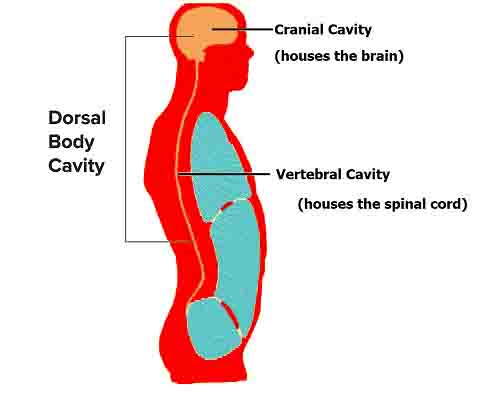Dorsal Cavity Definition
In vertebrates, the dorsal cavity surrounds the brain and spinal cord in a fluid-filled space. The dorsal cavity is usually divided into two semi-separate spaces, the cranial cavity and the spinal cavity, which house the brain and spinal cord, respectively.
However, the fluid in the dorsal cavity is completely separated from the blood, connecting the brain and spinal cord. Blood-brain barrier refers to the specialized epithelial cells that separate the brain from the dorsal cavity.
Function of the Dorsal Cavity
Dorsal cavities protect what’s inside by providing a cushion against damage and impact from the environment and other organisms. There is fluid surrounding the brain and spinal column, which acts as a buffer between the structures. Fluid inside the dorsal cavity is pressurized and pushed back as forces push against it. In this way, the force exerted on the brain and spinal cord is greatly reduced. Nervous tissue in both of these structures is highly sensitive and easily damaged.
There is a fluid surrounding the brain and spinal cord called cerebrospinal fluid. Special cells within the brain produce cerebrospinal fluid, a clear fluid. There are almost no proteins or red blood cells in the fluid, which is very similar to blood plasma.
In addition to protecting the brain, the cavity and cerebrospinal fluid allow wastes to be removed and intracranial pressure to be regulated. By performing these functions, the brain cells can work efficiently and blood pressure can be regulated.
It is interesting to note that the dorsal cavity and cerebrospinal fluid actually make the brain buoyant, which reduces its weight. When suspended in cerebrospinal fluid, a brain weighs around 50 grams instead of 1500 grams. The brain can be much bigger without collapsing under its own weight due to this massive decrease in functional weight.
Human Dorsal Cavity Parts & Organs
The dorsal cavity is composed of two parts: the cranial cavity and the vertebral (spinal) cavity. As a protective layer for the spinal cord, the dorsal cavity is formed by a membrane and the inside of the skull.
Cranial Cavity
It attaches to the skull bone just below the dura mater. It is attached just below the arachnoid membrane. This is the space between the cranial cavity and the pia mater. Several cross membrane support proteins support the cerebrospinal fluid filled cranial cavity.
Spinal Cavity
Similarly to the cranial cavity, the spinal cavity serves a similar purpose. Damage to the spinal cord is extremely sensitive, so it must be cushioned. In addition, the separation provides some protection against bacteria and viruses. The dorsal cavity provides an open space for immune cells to respond to these invaders when they attack the brain and spinal tissues.
Collecting Cerebrospinal Fluid through the Dorsal Cavity
Cerebrospinal fluid is collected by lumbar puncture, a common medical procedure. These fluids may be checked by doctors for a variety of reasons, many of which provide information about the condition of the dorsal cavity. It may be necessary to collect some fluid to test for bacterial proteins, for example.
An infection in the meninges, called meningitis, could be the cause of this. To ensure the dorsal cavity is functioning properly, doctors may also check the pressure and general condition.
Increasing intracranial pressure can be caused by a clogged or otherwise abnormal dorsal cavity. The leaking of the dorsal cavity can also result in headaches, decreased brain function, and other symptoms. A very narrow boundary of cerebrospinal pressure ensures the brain remains buoyant within the dorsal cavity without being overpressured.
Using a dorsal cavity fluid test, doctors can see what components are in the fluid, and which substances shouldn’t be present. As a result, diseases such as infection, cancer, and autoimmune disease can sometimes be diagnosed.

